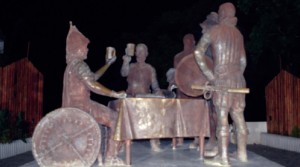
Forty four years earlier in Mactan, Cebuano chieftain Datu Lapulapu killed conquistador Ferdinand Magellan.
This time in the summer of 1563, Boholano Datu Sikatuna was on board the Spanish vessel of Miguel Lopez de Legazpi-toasting with the best Spanish goblets – a rare mixture of their own blood drawn from their left arms – and mixed with wine (maybe red European wine and tuba, who knows?) to signify their eternal friendship. Indeed a treaty of friendship of nations.
The dramatic episode captured in the immortal painting of Filipino painter Juan Luna’s “El Pacto de Sangre†(Pact in Blood) was to be the first international treaty of friendship in the Philippines. It was stark contrast to the morbid scene along the shores of Mactan Cebu (earlier) where perhaps scores of dead Spaniards and Filipinos were strewn – among them the proud Magellan, who was originally Portuguese.
The highest accolade for international diplomatic merit in the country today, in fact, is aptly named the “Sikatuna Friendship†Award. For good reasons.
It was not easy sailing for Legazpi, though. At first the Boholano natives were hostile and refused to give food and aid to the enemies who were “white men with beards.†Earlier, the Boholanos were pillaged and plundered by a group of Portuguese adventures – at that time in deep competition with Spain to conquer the so-called Spice Islands in the East Indies.
Timely it was that a Malayan interpreter convinced the Sikatuna Group that the Spanish team was not in the same camp of the rival Portuguese – and that the Legazpi team was really just in search for peace and trade. The rest is history.
The debate matters little now – if the treaty was indeed held in the Tagbilaran-Baclayon fringes or in Loay where some alleged was the only town capable of having deep-well water to quench the visitors’ collective thirst. It was a historical act of friendship.
That friendliness of the Boholanos then – probably rubbed on many of us through the march of centuries.
Today, Bohol is not just a tour favorite of many because of the fabulous sites and clime we have – but mostly because of the presence of quality human capital. We are proud to say Boholanos are one of the most friendly, hospitable and gentle people in this side of the globe. Homes are “open sesame†to all and sundry and even the poor folks will kill the last pig to celebrate fiesta among kin and friends – even if that meant to be indebted for a year. The host couple will give up the master’s bedroom – anytime – and sleep in the sala (mosquitoes and all) to accommodate guests from far away/
The Sikatuna-Legazpi Friendship seal is found in the Bohol flag and the emblem of the provincial government. For indeed the Boholano Sikatuna represented the nobility of the native warrior – who was expected to have the qualities of the equivalent Knights in Europe – generous, chivalrous and noble. He knew the benefits of peace and understood much earlier than the Chinese traders that “there is no prosperity in anger.â€
Sandugo in English means “one blood:†– and after the pact in blood – the Spaniards and Filipinos felt that they had “one common blood running through their veins.†The nobility in a Sikatuna – though scarred with many battles in the past – tamed the beast in him when confronted by a smiling enemy.
Our hero Sikatuna – noble as he was – understood what a modern preacher always believed. That unity and erasure of conflicts begins with acceptance. Not agreements, but acceptance. Not agreements, but acceptance. Not negotiation, but acceptance.  Acceptance about the brotherhood of nations – and realizing that there is no much to battle against in this world like poverty, disease, ignorance and climate change – for nations to even begin thinking about fighting and shedding human blood – against one another.
Thus the pomp and revelry during these Sandugo festivities these days in Bohol – are mere symbols of the greater values that should rule over the baser nature of man: unity, compassion and capacity to love.
That’s what “Sandugo†is – we are all of “one blood.†Let us celebrate.
